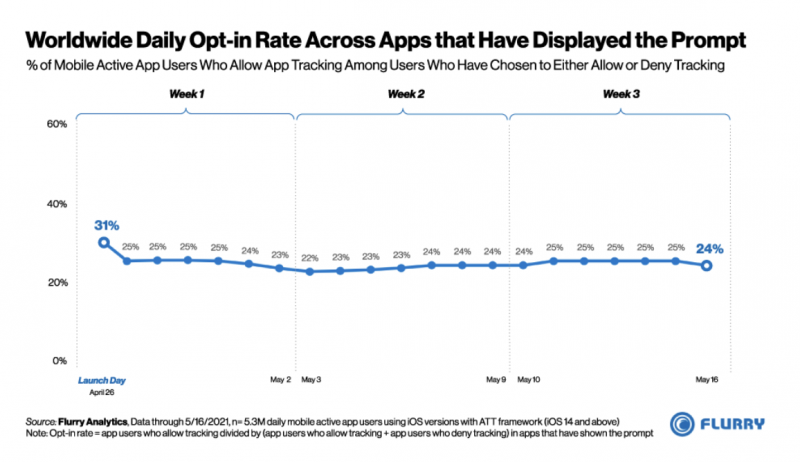Why creative automation is essential for app marketers post-IDFA
With Apple’s much-discussed App Tracking Transparency (ATT) now implemented, the job of adjusting to the changes in tracking and attribution have started in earnest. This means that a fresh look at their creative strategies is in order for advertisers and app marketers.
Without the ability to use IDFA as an easy way to target new and existing users, creative automation has become essential for developing effective creative ads that drive user engagement and installs.
The pressure on ad creatives to deliver results has never been bigger
Well-performing ad creatives have always been the cornerstone of any app marketing campaign. However, with reduced scope for precise targeting due to Apple's IDFA changes, there is an increased reliance on creative automation to ensure ads effectively drive installs.
Although it’s only been a few weeks since Apple made it mandatory for apps to require users to opt-in to be tracked via their IDFA, the data already shows a considerable drop in users agreeing to be tracked. According to Flurry, only a quarter of consumers shown the new opt-in prompt agree to receive targeted advertising.

This means that, barring some massive shift in consumers changing their attitudes to ad targeting (which is unlikely), advertisers and publishers need to find ways to boost their organic installs instead.
However, this shift comes with its own challenges. According to pre-IDFA research by eMarketer, 24% of app publishers found playable ads outperform other formats in driving organic installs. With reduced ad targeting capabilities, the effectiveness of playables at driving organic installs is expected to grow. As a result, many app publishers are likely to significantly increase their use of playable.
But producing creatives at scale – especially interactive creatives – requires specific skills and can be expensive, and that’s where automated platforms like Playturbo come in, providing an efficient and scalable solution for creating high-quality creative playable ads.
How automation is a game-changer for playable ads
Of all the ad formats, playable ads often demand significant time and budget investments. Even the simplest playable ads are complex to produce, requiring storyboarding, design, development, A/B testing, and refinement.
Implementing creative automation can streamline these processes, making the production of creative ads more efficient and cost-effective. Creative automation means that it is much easier and faster to scale a campaign and create multiple versions of creative ads. Since playable ads are HTML5-based, you don’t need to render and export the results every time you want to make a change.
Playturbo automatically combines the most effective creative elements and positions them to create the best performing version of the ad, taking the guesswork out of the creative process and iterating the ads virtually in real-time. The platform also includes ready-to-use templates for playable ads, helping advertisers streamline production and reduce costs.
In our post-IDFA world, leveraging creative automation to optimize your creative ads is essential for driving those all-important organic installs.
So many ad creatives, so little time
As app marketing campaigns have become more complex, the time to plan and execute them remains limited – meaning less time on the actual creative part and more on optimization.
Some ad industry estimates suggest that creative teams spend only 30-40% of their time actually coming up with the campaigns. Not only is that not the way to get the best from your agency or creative team, but it means it’s much harder to scale your campaigns as you are wasting a lot of the available resources already.
Automation tools like Playturbo can create multiple variations of a playable ad in seconds, whereas a human timescale to do the same would be measured in hours or days.
As organisations and advertisers become more comfortable with the idea of automating more mundane parts of the ad campaign process, there should be a bigger emphasis on getting back to the creative process – which is where innovations and great ideas are more likely to happen.
Marry context with ad creative
One of the biggest challenges advertisers face post-IDFA is the reduced access to user data, making it much harder to deliver the personalized ad experience the industry once relied on. As a result, advertisers need to better align the context in which an ad appears with the creative ads themselves.
This is where creative automation plays a critical role. Unless you are an advertiser with an unlimited budget, automating your ad creatives is the most effective way to scale your campaigns without significantly increasing your costs.
Conclusion
While the long-term repercussions on the mobile ad industry of Apple’s changes to IDFA are impossible to predict, the immediate challenge is how to create advertising campaigns that deliver great results regardless of whether someone has opted in or out.
The key to success is focusing on creative ads that engage users and drive installs. Platforms like Playturbo are revolutionizing the industry with creative automation, enabling advertisers to optimize ads at scale while keeping costs manageable. In a world where organic installs become more important than ever, offering users the best possible advertising experience is the most straightforward way to improve the performance metrics of your campaigns.
If you want to take your campaigns to the next level with innovative, engaging playable ad creatives, don't hesitate to contact the Playturbo team to see Playturbo in action. Don’t forget to also follow us on LinkedIn for the latest updates and insights!
